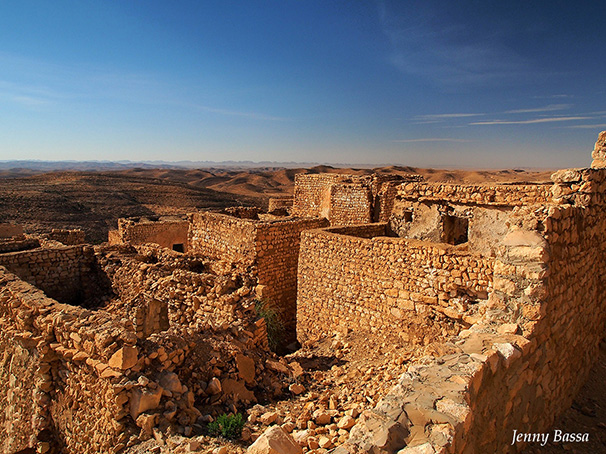After having been in the Tunisian Sahara desert, I thought I had seen the best of the North African country, better known for the coastal resorts on the Mediterranean, from Hammamet to Djerba. Instead I had to change my mind, because a few kilometers from Douz, the “door of the desert” , you can admire an infinite multiplicity of extraordinary landscapes, all different from each other.
 One of these is undoubtedly the one that opens to the east, towards Matmata, where the most famous Berber troglodyte villages of Tunisia are located , since, in 1977, George Lukas set one of the episodes of the Star Wars saga there. The reason is soon said: the landscape, lunar, apocalyptic, in all shades of brown, especially the lighter ones, lends itself well to the backdrop of sci-fi events, between layers of sand and clay, and steppe vegetation. Then you can see deep gorges in the ground : they are small Berber villages, some of them still inhabited, which took refuge here in the Middle Ages to escape the Arab colonization, giving rise to the notes and temperate cave dwellings.
One of these is undoubtedly the one that opens to the east, towards Matmata, where the most famous Berber troglodyte villages of Tunisia are located , since, in 1977, George Lukas set one of the episodes of the Star Wars saga there. The reason is soon said: the landscape, lunar, apocalyptic, in all shades of brown, especially the lighter ones, lends itself well to the backdrop of sci-fi events, between layers of sand and clay, and steppe vegetation. Then you can see deep gorges in the ground : they are small Berber villages, some of them still inhabited, which took refuge here in the Middle Ages to escape the Arab colonization, giving rise to the notes and temperate cave dwellings.
During my trip organized by Italy from Horizon Travel , I was able to explore one of these craters. I went under the ground through a small door carved along the side of a hill and I walked in dim light a long low corridor downhill until you come out in a circular courtyard open, dug into the soft rock and blinding because of the lime with which the walls were covered. There are a dozen doors, which I have freely crossed (obvious, in exchange for a final offer): they are the only openings of as many rooms dug into the terra, simple and tidy. Gentiles, the women in typical clothes invited me to sit on the carpets of a large room, where they served me a snack with surprising goodness: warm mint tea accompanied by pieces of bread to dip in a dish that mixes oil and honey together .
On the same day I was also in Zeraoua (a 4 × 4 required), an amazing medieval Berber village, in stone, camouflaged and abandoned on top of a sandstone hill , in a position as wonderful as hidden: in fact nothing but half between the desert, the fertile land and the sea that can be seen on the horizon, towards the east. After having lunch under the portico of a building of the foreign legion, built in a strategic position facing the village, I went among the buildings in stones and palm lintels of Zeraoua, which, if not damaged on the ground, are precariously balanced.
If it had not been for a harmless half-sized dog that kept barking along a slope at the entrance and for the many hens that were stirring among the ruined buildings, it would have been said that Zeraoua was completely uninhabited. Instead, as I walked away, I saw an old woman sitting in the dim light of a small lobby.
However, the effects of depopulation are evident also in the Berber village of Tamezret, perched on top of a hill overlooking the Dahar plateau , at 460 meters above sea level. The picturesque stone village , at whose feet passes the road to Matmata, is gradually crumbling, while the inhabitants move into new concrete houses, down into the plains.
On the other side of Douz, to the west, the scenery is pre-Grand Erg, the sea of sand that stretches from Algeria to the south of Tunisia . Shortly after leaving the beaten track, you reach, among low, blinding dunes of champagne-colored sand, an area in which traces of a dead city emerge. They are the ruins of abandoned Berber houses left at the mercy of time and desert, so much so that it is said that under each dune, between one palm and another, there is at least a submerged dwelling.
